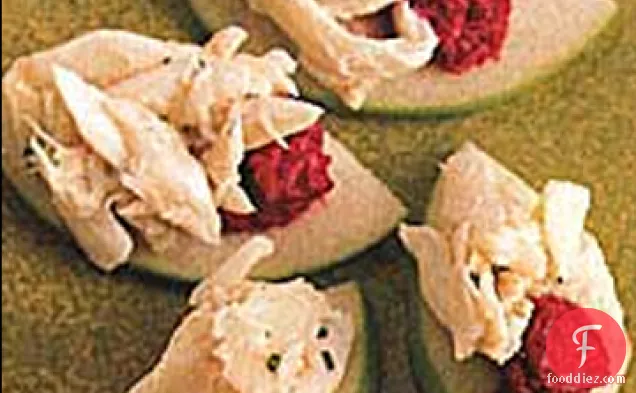Crab Meat and Beet Purée on Granny Smith Apple

Watching your figure? This gluten free, primal, and pescatarian recipe has 12 calories, 1g of protein, and 0g of fat per serving. This recipe serves 32. Head to the store and pick up granny smith apple, beet, chives, and a few other things to make it today. From preparation to the plate, this recipe takes roughly 45 minutes.
Instructions
2
Trim beet, leaving about 1 inch of stem attached, and wrap tightly in foil. In a small baking pan roast beet in middle of oven until tender, about 1 hour.
Ingredients you will need![Beet]() Beet
Beet![Wrap]() Wrap
Wrap
Equipment you will use![Baking Pan]() Baking Pan
Baking Pan![Aluminum Foil]() Aluminum Foil
Aluminum Foil![Oven]() Oven
Oven
3
Pick over crab meat to remove any bits of shell and cartilage. Slightly break up large pieces of crab meat and in a small bowl stir together with chives, lemon juice, 1 tablespoon sour cream, and salt and pepper to taste. Crab mixture may be made 6 hours ahead and chilled, covered.
Ingredients you will need![Salt And Pepper]() Salt And Pepper
Salt And Pepper![Lemon Juice]() Lemon Juice
Lemon Juice![Sour Cream]() Sour Cream
Sour Cream![Crab]() Crab
Crab![Chives]() Chives
Chives
Equipment you will use![Bowl]() Bowl
Bowl
4
Unwrap beet carefully. When beet is just cool enough to handle, slip off skin and stem and cut beet into a few pieces. While beet is still warm, using a mortar and pestle mash beet until smooth. In a small bowl stir together mashed beet, vinegar, remaining ‚ tablespoon sour cream, and salt and pepper to taste. Beet purée may be made 1 day ahead and chilled, covered.
Ingredients you will need![Salt And Pepper]() Salt And Pepper
Salt And Pepper![Sour Cream]() Sour Cream
Sour Cream![Vinegar]() Vinegar
Vinegar![Beet]() Beet
Beet
Equipment you will use![Mortar And Pestle]() Mortar And Pestle
Mortar And Pestle![Bowl]() Bowl
Bowl
Ingredients
Recommended wine: Chardonnay, Muscadet, Riesling
Shellfish on the menu? Try pairing with Chardonnay, Muscadet, and Riesling. Buttery chardonnay is great for scallops, shrimp, crab, and lobster, while muscadet is a classic pick for mussels, oysters, and clams. If you've got some spice in your shellfish, a semi-dry riesling can balance out the heat. One wine you could try is Tyler Winery Santa Barbara County Chardonnay. It has 4.1 out of 5 stars and a bottle costs about 30 dollars.

Tyler Winery Santa Barbara County Chardonnay
2015 brought the earliest vintage of the decade so far. After the large 2013 and 2014 vintages and the continued drought, the vines put forth a fraction of the fruit than the previous two years. They were down approximately 30% overall but the result was exceptional quality and deep, powerful wines with great acidity. Citrus, anise, saline, and energetic.DifficultyExpert
Ready In45 m.
Servings32
Health Score3
Related recipes
Garlicky Green Beans
Fruity Cookie Tarts
Roasted Russet & Sweet Potato Wedges
Cheesy Vegetable Frittata
Magazine

Your Inner Chef with Taylor Swift's Top 3 Recipes from Her Beloved NYC Hangout

20 Mouthwatering Recipes You Need to Try Today!

Master the Art of Making Perfect Pancakes with This Foolproof Recipe

The Science Behind Red Wine: Its Surprising Health Benefits and Potential Risks

12 Wine Cocktails for a Sophisticated Twist

Sip, Swirl, and Celebrate: Toasting to National Wine Day on May 25th

National Drink Wine Day on February 18

Celebrating Souffle Day with Delectable Delights

Indulge in the Delightful Flavor of Oyster Soup on Its Special Day!

Celebrating World Nutella Day

12 Healthy Spring Menu Ideas for 2022

Celebrate Spring with 3 Fresh Dishes

10 Healthy Springtime foods and How to Prepare Them

5 Simple Guidelines to Demystify 'Seasonal Cooking'

How to Grill Vegetables

How to Make Overnight Oats

How to Make Quiche

22 Dinner Ideas for Warm Summer Nights

23 Healthy Summer Recipes

30 Light Recipe Ideas for Hot Summer Days

Your Inner Chef with Taylor Swift's Top 3 Recipes from Her Beloved NYC Hangout

Celebrate National Pizza Day on February 9th with Mouthwatering Slices and Fun Facts

10 Foods that Relieve Constipation Naturally

Discover the Nutritional Superpowers of a Brown Food Diet

Indiana's Exciting Addition to the Summer Food Program for School Children

Readers' Top Picks for the Best Restaurant Desserts on National Dessert Day

Artichoke Tomato Pesto Flatbread Recipe A Scrumptious Twist on Savory Classics

Mastering Weeknight Meals with 30 Days of 25-Minute Dinner Recipes

Healthy and Delicious 5-Ingredient Breakfast Recipes












